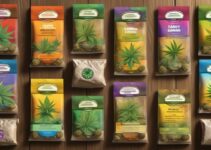Did you know that according to a recent study, climate change is expected to significantly impact marijuana cultivation in the coming years? As the environment becomes more unpredictable and extreme, it's crucial to consider the resilience of the seed strains you choose. By selecting climate-resilient marijuana seed strains, you can ensure the success of your outdoor cultivation. But what exactly makes these strains resilient, and how can they benefit your cannabis growth? Let's explore the factors that make climate-resilient seed strains a wise choice for your marijuana cultivation endeavors.
Key Takeaways
- Assess the climate conditions of your region before selecting seed strains.
- Consider factors such as sunlight, temperature, and precipitation when choosing strains.
- Different strains thrive in different climates, so choose strains that align with your specific weather patterns.
- Optimize cannabis growth and maximize resilience by selecting strains well-suited to your climate.
Understanding Climate Resilience in Marijuana Seeds
When selecting marijuana seeds for cultivation, it is crucial to carefully assess the climate conditions of your region and choose strains that are best adapted to the specific environmental factors, such as sunlight, temperature, and precipitation. Understanding the climatic requirements of marijuana seeds is essential for successful outdoor growing. For instance, in a Mediterranean climate, where the growing season is characterized by long, warm summers, late-blooming sativas are a resilient choice, thriving from April to Croptober. Conversely, in a Northern European climate with a short spring/summer window, tough ruderalis strains are better suited. Hybrid strains offer versatility and can be an optimal choice for moderate climates with varying temperature and precipitation patterns. To ensure the resilience of your marijuana crop, consider the amount of daily sunlight your plants will receive during the growing season and select seed strains that align with the specific climatic conditions of your region. By understanding the unique climatic needs of different marijuana seed strains, you can maximize the success of your outdoor cultivation endeavors.
Factors Influencing Seed Strain Selection
Assessing the specific climate conditions of your region is imperative when considering factors that influence the selection of marijuana seed strains for cultivation. Factors such as hot temperatures, high humidity, and sunlight hours play a crucial role in determining the suitability of seed strains for outdoor cannabis cultivation. For hotter climates, consider autoflowering strains and Sativa varieties, known for their resilience to high temperatures and long flowering periods. In contrast, for colder climates, opt for indica strains and photoperiod strains bred for cold northern latitudes, offering faster growth and shorter flowering times for earlier harvests. Additionally, consider the amount of daily sunlight and weather patterns in your region when selecting climate-resilient marijuana seed strains. By choosing strains best suited for your specific climate, taking into account temperature, precipitation, and sunlight hours, you can ensure the successful cultivation of marijuana plants. Understanding these factors is essential for selecting seed strains that can thrive in the unique climate conditions of your region, ultimately leading to a successful and resilient cannabis cultivation.
Importance of Climate Adaptability in Seed Choices
Selecting marijuana seed strains with high climate adaptability is crucial for successful cultivation in varying environmental conditions. The importance of climate adaptability in seed choices cannot be overstated, especially when cultivating cannabis in outdoor settings. To underscore the significance of this, consider the following:
- Consider the amount of daily sunlight your cannabis plants will receive during the growing season to select appropriate strains for your climate zone.
- Opt for late-blooming sativas in Mediterranean climates and tough ruderalis strains in Northern European climates to best suit weather conditions.
- Choose photoperiod and autoflowering strains bred to thrive in colder climates in cool northern latitudes for faster growth and earlier harvests.
- Consider autoflowering varieties for a long growing season in hot, dry southern climates, and provide shade to protect plants from excessive heat.
- Select high-caliber Hazes and sativa hybrids for warm-wet coastal climates and harvest from September onward to prevent mold and fungus.
These guidelines reflect the need for well-adapted strains resistant to varying climatic conditions, ensuring a successful and resilient marijuana cultivation experience. By carefully considering climate adaptability in seed choices, growers can optimize their harvests and ensure the robustness of their cannabis plants.
Optimizing Cannabis Growth for Your Climate
You must carefully analyze the amount of daily sunlight your cannabis plants will receive during the growing season. It is crucial to consider strains that are best suited for your climate zone based on specific weather data, such as hours of sunlight, temperature, and precipitation. For example, in a Mediterranean climate, growing late-blooming sativas from April to Croptober is recommended, while in a Northern European climate, opting for tough ruderalis strains during the short spring/summer window is advised.
Climate-Specific Growing Techniques
To optimize cannabis growth for your specific climate, carefully analyze the amount of daily sunlight your plants will receive during the growing season and select the appropriate strains accordingly. Consider weather data such as hours of sunlight, temperature, and precipitation to choose strains best suited for your specific climate. Here are some climate-specific growing techniques to help you grow your cannabis plants successfully:
- Choose late-blooming sativas for Mediterranean climates
- Opt for tough ruderalis strains for Northern European climate
- Select versatile hybrid strains for moderate climates
- Opt for photoperiod and autoflowering strains bred for colder climates
- Choose autoflowering varieties and photoperiod strains suited for long growing seasons in hot, dry Southern European climates, and provide shade to protect plants from excessive heat.
These techniques will help you cultivate climate-resilient marijuana seed strains tailored to your specific climate.
Adaptation to Environmental Factors
When optimizing cannabis growth for your specific climate, carefully analyze the amount of daily sunlight your plants will receive during the growing season to select appropriate strains. In hot weather and high temperatures, opt for strains that thrive in a hot, dry climate with low humidity. Consider local climate data to determine the ideal growing conditions for your marijuana plants. In extreme temperatures, such as hot and humid climates, it is crucial to choose strains that can adapt to humid conditions. For climates with harsher conditions, select cannabis strains that are resilient and can withstand the challenges posed by the environment. By considering these environmental factors and selecting climate-resilient marijuana seed strains, you can optimize your cannabis growth for your specific climate.
Maximizing Resilience With Seed Strain Selection
When selecting marijuana seed strains, it is essential to consider the environmental adaptability and diversity of the strains available to you. Choose strains based on specific climate zones, taking into account factors such as sunlight, temperature, and precipitation. By carefully selecting strains that are well-suited to your climate, you can maximize resilience and optimize the potential for successful marijuana cultivation.
Seed Strain Diversity
Maximize resilience in marijuana cultivation by carefully selecting seed strains tailored to your specific climate zone, taking into account factors such as sunlight, temperature, and precipitation. When considering seed strain diversity, it's crucial to choose varieties that align with your climate for optimal performance. For a hot climate with long growing seasons, look for outdoor marijuana seeds with sativa genetics that can thrive in hot summers. Autoflowering cannabis strains are ideal for regions with unpredictable weather patterns, allowing for flexibility in planting and harvesting. Hybrid seed varieties offer versatility and resilience, making them suitable for a range of climates. For colder regions, opt for photoperiod and autoflowering strains specifically bred to withstand lower temperatures, ensuring successful cultivation despite challenging weather conditions.
Environmental Adaptability
Selecting marijuana seed strains tailored to your specific climate zone is crucial for maximizing resilience and environmental adaptability in cultivation. For outdoor growers in hot, humid climates or areas with short growing seasons, choosing climate-resilient strains is essential. Consider strains that can withstand high heat and humidity, such as late-blooming sativas for hot regions and tough ruderalis strains for areas with short growing seasons. Hybrid strains offer versatility and can thrive in moderate climates, making them a suitable choice for a summer crop. In cooler northern latitudes, autoflowering strains are ideal due to their faster growth and shorter flowering times. For long growing seasons in hot, dry southern climates, both autoflowering varieties and photoperiod strains can be viable options. By selecting seeds tailored to your climate, you can maximize environmental adaptability and ensure successful outdoor cultivation.
Climate Considerations for Marijuana Seed Varieties
Consider selecting marijuana seed strains suited for your specific climate zone based on weather data such as sunlight, temperature, and precipitation. Climate considerations are crucial when choosing strains, as they directly impact the plant's growth and overall yield. For hot climates, opting for autoflowering seeds can be advantageous, as they are genetically designed to thrive in such conditions. Additionally, growing in a hot environment may necessitate the use of specific strains like Royal Haze Automatic and Northern Light Automatic, which are known for their resilience in hot, dry Southern climates. On the other hand, for warm-wet coastal climates, high-caliber Hazes and Sativa hybrids are recommended, with a focus on harvesting from September onward to avoid mold and fungus issues. Furthermore, in cooler Northern Latitudes, selecting photoperiod and autoflowering strains bred to thrive in such conditions can lead to faster growth and shorter flowering times, enhancing overall cultivation outcomes.
- Opt for late-blooming sativas in Mediterranean climates and tough ruderalis strains in Northern European climates.
- Choose photoperiod and autoflowering strains bred to thrive in cooler Northern Latitudes with faster growth and shorter flowering times.
- For hot, dry Southern climates, consider autoflowering varieties like Royal Haze Automatic and Northern Light Automatic, or photoperiod strains like OG Kush and Sour Diesel.
- In warm-wet coastal climates, consider high-caliber Hazes and Sativa hybrids, and harvest from September onward to avoid mold and fungus.
Frequently Asked Questions
What Are the Two Most Important Strains of Marijuana?
Indica vs Sativa: The two most important strains of marijuana. Indica offers high THC, low CBD, and medical benefits, while Sativa is sought for its recreational use and legal effects. Hybrid varieties combine these traits for diverse cultivation and terpene profiles.
What Is the Best Strain to Grow in the Summer?
For outdoor summer growing, prioritize heat-tolerant, pest-resistant strains with ideal genetics for your climate. Consider sunlight, watering, soil, and THC content. Opt for varieties like Royal Haze Automatic and Northern Light Automatic for a successful harvest.
What Are the Best Cold Resistant Strains?
For outdoor cultivation, genetics selection is crucial for frost protection and climate adaptation. Top strains like Northern Light Automatic and Royal Haze Automatic offer high yield potential and are bred for cold weather, high altitude, and extreme conditions.
What's the Most Expensive Marijuana Seed?
The most expensive marijuana seed is a result of rare genetics in high demand, with limited supply. It offers top quality and unique characteristics, cultivated by exclusive breeders for the luxury market, making it a collector's item.





